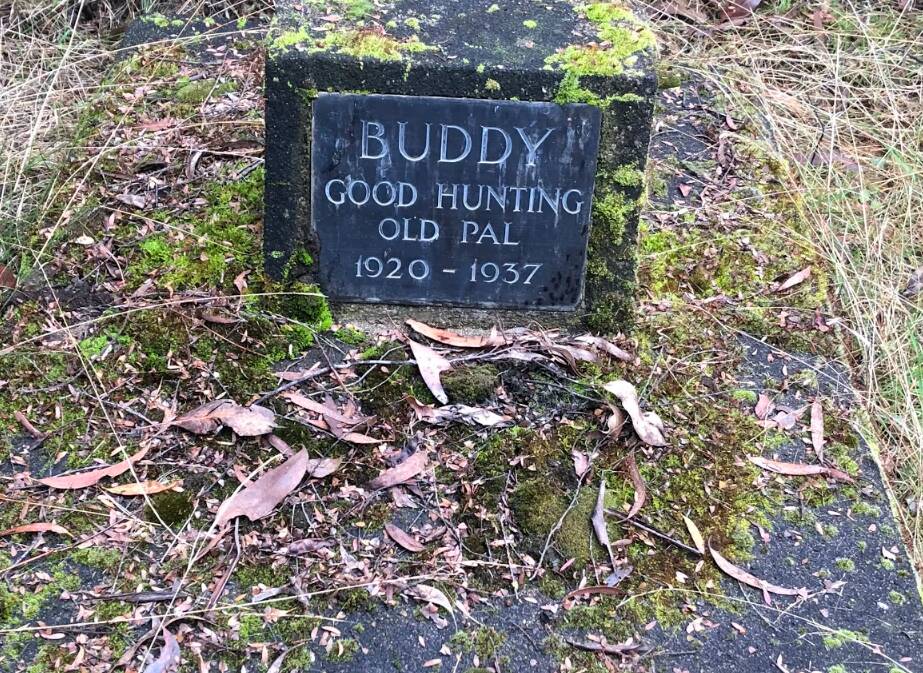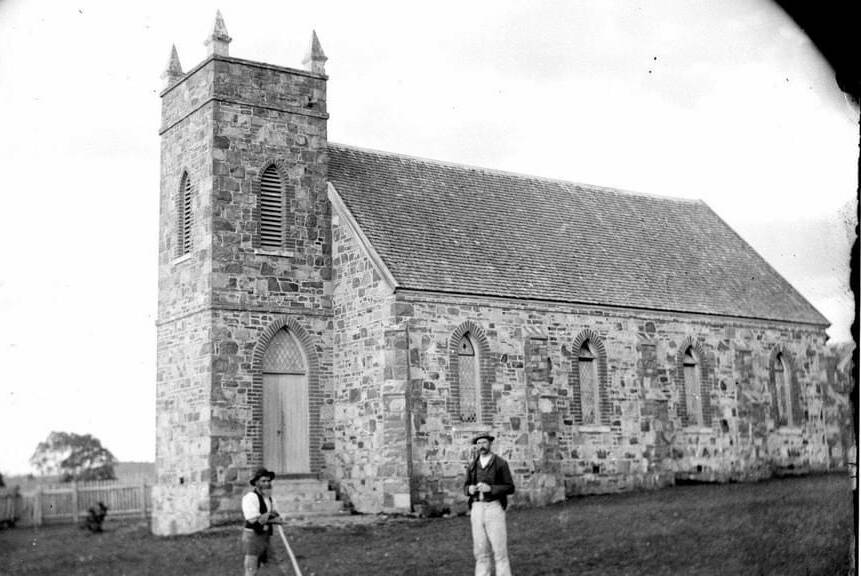
COVID changed the way many of us mark Anzac Day.
During the first lockdown, in April 2020, we were encouraged to commemorate Anzac Day, and in particular the dawn service, by standing at the end of our driveways with a candle or torch and listening to the service on the radio.
I'll never forget standing in the pre-dawn gloom near my letterbox and hearing a distant bugler in our suburb attempt to play the Last Post. It didn't matter it was way off-tune. It was haunting and emotional.
At the same time as I was listening to that local bugler, further south at his family property near Rocky Plain between Berridale and Eucumbene, Matthew Hedger and his wife Fiona were also listening to the national dawn service.
"We lit a fire, and while waiting for the sun to rise we listened to the Anzac service on the radio" recalls Matthew.
"I felt a real connection, it was quite emotional and powerful ... we plan to do it every year from now on."
His five-year-old Jack Russell, Buddy, joined them, watching the sun creep up over the rugged realms of the mountains near Lake Eucumbene.
Matthew says that, as the sun rises each Anzac Day, his thoughts now turn to all Australians who have served in the armed forces, and especially to those he has a close connection with.
"My mum's uncle, Private Negus Brown, was killed in action on October 16, 1917, and is buried at Villers-Bretonneux - and my grandfather, Corporal Roy Hedger [1920-2010], served as a Bren gunner on Kokoda and was wounded four times," he reveals.
Matthew's uncle, Ian Burke of Berridale, was especially moved when he first saw the photo of Buddy sitting at attention next to the fire.
"Quite a number of men from the mountains went to both wars - so the dawn fire up there is particularly poignant," he says.
"It [the photo] makes me think of all the men who went off to war and left their best mates, their dogs, behind. The dogs played their bit by waiting to welcome their masters when they returned, but some didn't return."
Digger the courageous canine

Still on dogs and memories of war, while fossicking through the Australian War Memorial archives, I recently stumbled upon a fetching photo of Digger, a dark brown and white stray bulldog that attached himself to soldiers training at Broadmeadows near Melbourne in October 1914.
Sergeant James Harold Martin took a particular liking to the four-legged stray, and smuggled him on the troop ship, Carew, bound for Gallipoli.
Martin initially served with the 1st Divisional Signal Company in Gallipoli, but was later transferred to the Western Front in France and Belgium, and everywhere he went, Digger went with him. The two had an unbreakable bond.
According to records held by the war memorial, Digger "went over the top" of the trenches 16 times and endured some of the worst battles on Gallipoli and the Western Front. The brave bulldog was wounded several times - including at the battle of Lone Pine, where a bullet pierced his jaw. He lost three teeth and the sight in his right eye. He was also badly burnt with mustard gas at Pozières in 1916.
For Martin and his fellow soldiers, Digger was a faithful hero who was always there not only for companionship but also to take food to wounded men and transport urgent written messages from wounded soldiers.
With Martin declared medically unfit to continue to serve, the inseparable duo returned together to Australia on May 12, 1918, where they settled in Sydney. Luckily for Digger, he just avoided the introduction of strict quarantine regulations relating to the arrival of dogs.
The two returned as heroes, and to help cover Digger's ongoing and considerable veterinary expenses, the public rallied, buying thousands of fundraising postcards of Digger resplendent in the inscribed silver collar made for him on his return to Australia, with patriotic red, white, and blue ribbons attached.
Digger was also presented with a free public transport pass so that he could accompany Martin wherever he went. This no doubt came in handy, as Martin and Digger attended several ceremonies and marches in support of recruitment, fundraising and returning men over the next year.
Ironically, Digger died on Empire Day (May 24, year unknown) when he was frightened by exploding fireworks. The war memorial reports, "Thinking he was under fire again, he attempted to jump the fence but failed and fell back with a burst blood vessel. Digger managed to crawl back into the house and died on Martin's bed." Loyal to his last breath.
In 2019, Digger was posthumously awarded Australia's first Blue Cross Award for valour - described as the "animal equivalent of the Victoria Cross" - and his tanned hide is held at the war memorial, stretched with darts to make it sit flat and with bulging glass eyes set deep into the eye sockets. It's a bit gory to share on these pages.
Like so many World War I veterans, Martin battled PTSD in silence and had one functioning lung because of mustard gas poisoning suffered during the war. He died in 1963 aged 71.
Did you know? Digger isn't the only dog mascot in the war memorial's photographic collection, which also includes a portrait of "Punch Anzac", the bulldog mascot aboard HMAS Australia (circa 1915-20) and another unnamed bulldog mascot (circa 1940-50) from HMAS Cerberus.

Remote grave
Still on curious canine capers, on a recent trip up the Goodradigbee River near Brindabella, David Vincent, this column's adventurous fishing correspondent, made a pilgrimage to the final resting spot of another four-legged Buddy, this one a blue heeler.
The grave of Buddy, the four-legged companion of World War I digger-cum-hermit Bob Reid, was highlighted in this column back in 2012, and for many years David has regularly visited the site.
"You really do need to go out of your way to find the grave, especially as the years go by and the blackberries and bush reclaim the surrounds," explains David.
In his book, Recollections of Growing Up in the Thrilling Thirties (2005), Ian MacDonald writes that Bob "had been wounded in the head [in the war] and wore a metal plate bolted to his cranium, as he explained 'to keep his few brains from falling out'."

The grave was erected in 1937 after Bob's beloved dog was bitten by a snake with MacDonald, a neighbour, arranging the plaque.
While David doesn't have a direct connection with Bob, he admits to having "a deep respect for the history of the beautiful green valley and the wildness of the ranges and the pioneering memories it serves up on each visit".
"Standing in what is still remote country and remembering all those who pushed through the valley and out the other end up the bridle track to Kiandra and Rule's Point, seeing the gold races the first gold seekers dug out is a good reminder of how tough life was in the Brindabella Valley," he says.
As the fisherman poet Douglas Stewart termed the lost valley of Brindabella, when he wrote about Bob and W. P. Bluett of Koorabri [a property in the Brindabella Valley], "it was old worn country and like old Bob, the lair of old worn-down people ..."
WHERE IN THE REGION?

Rating: Medium
Clue: Site of a world speed record in the 1970s.
How to enter: Email your guess along with your name and suburb to tym@iinet.net.au. The first correct email sent after 10am, Saturday April 23, wins a double pass to Dendy, the Home of Quality Cinema.

Last week: Congratulations to Andy Hogan of Bonython, who was first to correctly identify last week's photo as the St Stephen's Anglican Church in Majors Creek, taken circa the late 1890s. Andy just beat Peter Stevenson of Macarthur, who has "camped in the nearby recreation reserve", and Brian Carter of Jerrabomberra, to the prize.
Special kudos to Andy, who entered the competition while on a ship midway between Kangaroo Island and Devonport. "As a FIFO worker on ships, when he is away for work, I send him a photo of your competition first thing on Saturday morning," explains his wife Toni, adding he looks forward to seeing if he knows the location.
The clue of "Major William" related to Major William Sandys Elrington, a British military officer and early settler of the area, after whom the village, located about 16 kilometres south of Braidwood, is named.
This year marks 150 years since the construction of the church, using 120 pounds raised by the local community, was completed. Recently, $20,000 was received by bequest which was used to fix cracks and replaster the interior.

At the foundation ceremony on November 19, 1870, attended by 300 to 400 people who enjoyed lunch under a marquee composed of bushes (really!), several valuable coins, along with a list of those pivotal in the church's construction, were placed in a bottle and buried in the foundation stone. According to the rector's warden, Brian MacDonald, "the foundation stone is located somewhere in the north-east corner of the church, but its exact location is not known". Oh, I love a good mystery.
SIMULACRA CORNER

Michael Hall of Hawker recently spotted this "creature" lurking in the undergrowth at the Pinnacle Nature Reserve in Belconnen. He reckons it could be a "Yowie". Hmm, I think I'd need to check out that its feet were sufficiently of Bigfoot size before passing judgement.
CONTACT TIM: Email: tym@iinet.net.au or Twitter: @TimYowie or write c/- The Canberra Times, PO Box 186, Fyshwick, ACT, 2609







